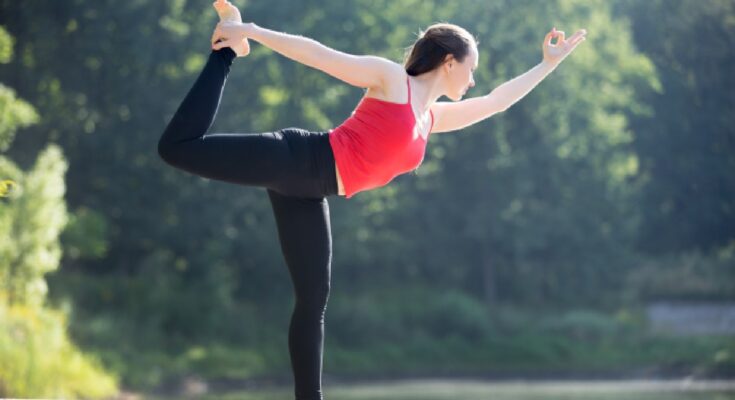The dancer yoga pose or Natarajasana strengthens the muscles of the chest, shoulders, and back. Here’s how to do this pose.
Natarajasana, commonly known as the Dancer Yoga Pose, is a graceful and challenging asana that embodies the beauty and strength of a dancing figure. This asana earns its name from the Sanskrit words “Nata,” meaning dance, and “Raja,” meaning king or lord. Translated as the Lord of the Dance Pose, it signifies the beauty and grace of a celestial dancer, encapsulating the fluidity and expressiveness of dance within the structure of a yoga pose.
This is an interesting pose because it offers a unique blend of physical and mental benefits. Natarajasana, or the Dancer Pose, is a standing balance pose that requires strength, flexibility, and concentration. The practitioner stands on one leg while holding the other leg behind the body, resembling the pose of a dancing figure. This asana is a dynamic expression of balance, poise, and elegance. Let’s find out more about the intricacies of the dancer yoga pose and its potential benefits.

What are the benefits of dancer yoga pose?
Yoga expert Dr Hansaji Yogendra explains all the essential benefits of a dancer yoga pose.
1. Improves balance and concentration
Natarajasana requires focused attention, engaging the brain in balance control and concentration, which helps improve neuro-muscular coordination.
2. Strengthens leg muscles
The standing leg bears the weight of the body, activating and strengthening the muscles in the thighs, calves, and ankles.
3. Enhances flexibility of the spine
When you arch your back while performing Natarajasana, it promotes spinal flexibility, stretching, and toning of the muscles along the vertebral column.
4. Opens the chest and shoulders
The lifted leg’s backward extension opens the chest and shoulders, improving respiratory function and promoting better posture.
5. Stimulates the abdominal organs
The balancing aspect engages the core, stimulates abdominal organs and improves digestion.
6. Improves hip flexor flexibility
The lifted leg’s position stretches and strengthens the hip flexors, contributing to increased flexibility and reduced stiffness.
7. Promotes emotional well-being
The graceful, expressive nature of Natarajasana can induce a sense of joy and release emotional tension, promoting overall mental well-being.
How to do the dancer yoga pose?
Here’s a step-by-step way to do Natarajasana or dancer yoga pose:
- Step 1: Stand straight with your hands by your side.
- Step 2: Shift your body weight to one leg.
- Step 3: Bend the knee of the other leg, bringing the heel toward the hips.
- Step 4: Reach back with the corresponding hand and hold the ankle.
- Step 5: Inhale, lift the opposite arm upward.
- Step 6: Keep the lifted foot into the hand, extending the leg back and arching the spine.
- Step 7: Maintain balance while looking forward.
Common mistakes to avoid
- Overarching the back may strain the lower back, leading to discomfort or injury.
- Improper technique may result in a loss of balance and potential falls.
- Putting too much pressure or improper alignment can put strain on the knees and ankles.
- Lifting the head too high may strain the neck, leading to discomfort.
Natarajasana imparts strength and grace at the same time. Every muscle in the leg – feet, ankles, thighs, and pelvis is stretched in this asana. There is a gentle opening of the hips which releases any blocked energy. It strengthens the muscles of the chest, shoulders, and back.

Who should avoid dancer yoga pose?
- Patients with recent or chronic injuries to the ankles, knees, or hips.
- Pregnant women, especially in the later stages of pregnancy.
- Those with high or low blood pressure.
- Patients with a history of heart conditions.
- People with vertigo or balance disorders.
Keep in mind!
Natarajasana or dancer yoga pose should be performed with Jnana Bhava. Bhavas are feelings to be generated whenever you are doing certain asanas. Jnana Bhava is about knowledge, concentration, and body awareness. While practising Natarajasana, watch yourself very closely to know more about yourself. Try to gain more neuromuscular coordination and synchronise your muscles with your mind, breath, and emotions. You will be able to achieve this with concentration and a steady practise of Natarajasana, says the expert.
Source link






